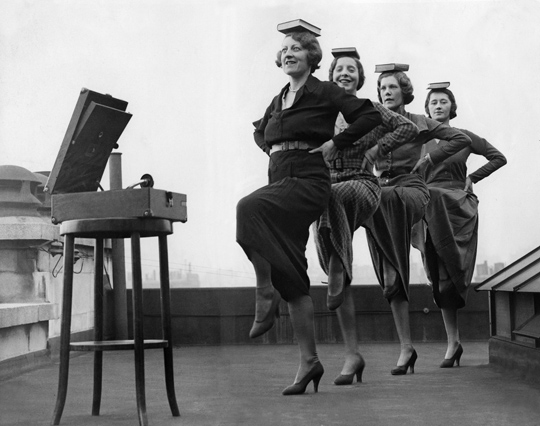Agents of the Golden Twenties
Freiburg, Feb 27, 2019
The Weimar Republic’s 1919 constitution ushered in a new cultural phase. For the first time, the freedom of art was guaranteed by law. Freiburg professor of German Studies Sabina Becker believes that the democratization of society and the democratization of culture went hand-in-hand. Whether it was novels, movies or dance revues - Becker says the new social layer of office workers was the most open to the new forms.

Lunchbreak on the roof: Many women made their way into the workplace as sales assistants or stenographers - and they didn’t neglect the issue of fitness at work. Photo: Ullstein Bild/Timeline Images
Packed movie theaters, scandalous stage shows, new subjects for novels, and architecture which remains world-famous even today - as the November 1918 revolution put an end to the monarchy and the republic was declared, a new age of artistic creativity began - for the democratization of society also meant democratizing culture. For the first time, freedom of expression in art was guaranteed by the constitution: “Art, science, and their teaching are free. The state ensures their protection and participates in nurturing them,” the document states.
Last year’s television series, “Babylon Berlin” took an enthusiastic audience on a journey to Berlin of the “Golden Twenties.” Yet researchers long regarded the Weimar Republic period culturally as merely entre des guerres, with nothing much to offer. “That is not quite right,” says Professor Sabina Becker of the Institut für Neuere Deutsche Literatur at the University of Freiburg. In her book, “Experiment Weimar. Eine Kulturgeschichte Deutschlands 1918–1933” (The Weimar Experiment. A Cultural History of Germany, 1918-1933), Becker explains why that time should be seen as an era in its own right. She says the artists wanted to make the most of the new freedoms and the democratization process at work in Germany.
Distraction for the office workers
As early as 1919, the boom years began for Germany’s cinemas. From the mid-1920s, huge movie palaces opened with 1,600 or more seats – the movies had become a mass medium. “Movies were the distraction culture of the office workers,” Becker explains. Generally, culture was no longer created just for a bourgeoise elite. The fresh social class of office workers, which had only existed since the 1880s, became more diverse during the Weimar Republic. Not only men - women too worked in the new department stores and in an ever-growing administrative apparatus. “These workers were the most open to the new cultural forms - they aimed to expand their educational horizons and were interested in American influences. That made the men and women of this class into agents of modernization for the German perception of culture.”

Consumer palace at Leipziger Platz: The Wertheim department store in Berlin was long considered Germany’s finest; with a sales area of 70,000 square meters, it was also the biggest in Europe. Photo: Waldemar Titzenthaler/Wikimedia Commons
But 1920s white-collar workers were not only important as the recipients of the new developments in German art. They themselves became a subject for literature and film. Authors began to describe their world, life in the big cities - and to portray it in a positive light for the first time. Above all, they described the lot of women, who were not only finding a place in the professional world, they fought for and gained the right to vote. A typical example is the 1931 novel “Mehlreisende Frieda Geyer. Roman vom Rauchen, Sporteln, Lieben und Verkaufen” (Frieda Geyer. A Novel of Smoking, Sport, Love and Sales.) by Marieluise Fleißer. The style is matter-of-fact; the pathos which still existed in the age of Expressionism disappeared after the war, Becker says.
New architecture in all the cities
The republic’s first constitutional assembly in 1919 was held in Weimar – chiefly to escape the overheated political climate in Berlin. But the choice of location had a symbolic function as well. Those in power wanted to show they were making policies not just for the capital, but for all the regions of Germany. And the cultural developments did not just happen in Berlin, Becker explains. “We need to crack open this stereotype that art only modernized in Berlin.” It’s true that the capital was a dynamic and open metropolis which developed quickly both culturally and technologically; but a look at the architecture of the time clearly shows that change was happening all over the country. The world’s most famous school of architecture, the Bauhaus, was founded in Weimar in 1919. From there, the new style was stamped on many building projects in German cities - for instance, the “New Frankfurt” project in Frankfurt am Main, residential developments in Dessau and Stuttgart, and new museums in the Ruhr Valley. “Every area opened up to the new cultural phase,” says Becker. Only Munich was reluctant.
Yet Becker says we cannot lose sight of the problems of this era - such as losing the war and the economic burden. The social layer of white-collar workers was the first to be hit by the start of the Great Depression in 1929. There were mass dismissals in department stores and administrations, while factory workers were still needed on the factory floors. In his 1932 novel “Little Man, What Now?” Hans Fallada detailed the situation of office workers in this period. Yet despite all the crises and the subsequent Second World War, the cultural ideas of the Weimar Republic did not end when it did, Becker says. “They form the central foundations of our understanding of culture today.”
Annette Kollefrath-Persch

